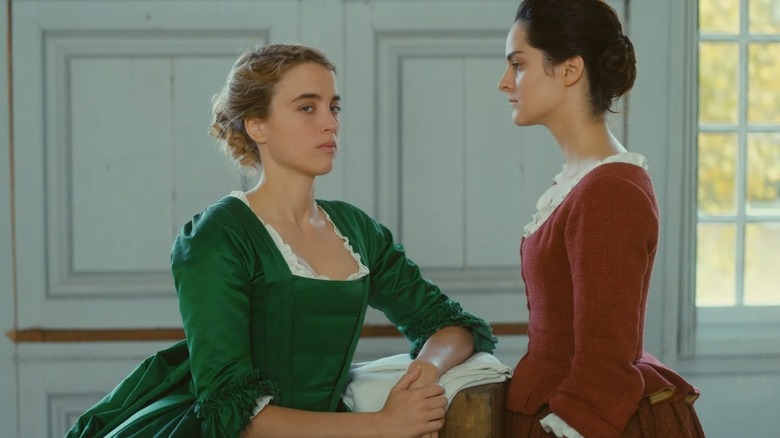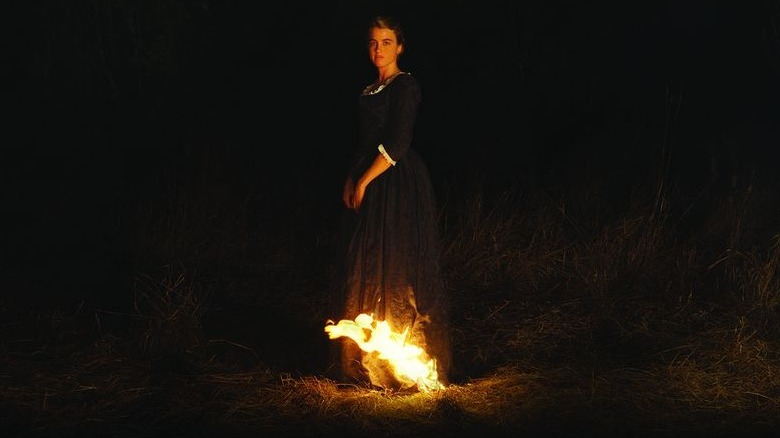Celine Sciamma Used One Key Scene As The 'Compass' For Portrait Of A Lady On Fire
When Marianne (Noémie Merlant) and Héloïse (Adèle Haenel) lock eyes for the first time in Céline Sciamma's "Portrait of a Lady on Fire," they do not immediately fall in love. Marianne, who has been hired by Héloïse's mother to secretly paint her for a wedding portrait, gazes at her subject with the curiosity of an artist dedicated to her task. In turn, Héloïse watches Marianne watch her with bristling indignation — for the first half of the film, she is cautiously distant, a little cold, and clearly defensive at the prospect of a stranger suddenly invading her space. Over time, their relationship develops into passionate, all-consuming love that understands its limits and acknowledges that it is not meant to be. Years after their mutual separation, they still burn for one another.
The title of Sciamma's film, which directly connects to a pivotal scene where Héloïse's skirt literally catches fire, acted as the north star for the filmmaker's vision of two women in love. The kind of love they share is completely removed from expectations that spring from the male gaze: there are no disbalances in power that the two hold over each other, and Héloïse, despite being the subject of Marianne's gaze, is never an object of desire. In an interview with The Daily Beast, Sciamma explained how the leads never smile coyly right after crossing paths to cater to the standard expectations of a romance film. The reason? "They don't have to," Sciamma says, as the two "concentrate ... share the loneliness," making it meaningless for them to perform for the camera/the audience.
In the same interview, Sciamma also talked at length about one scene that served as a "compass" for the film.
Let's set fire to her
Sciamma talked about the deliberate kernel of rebellion embedded into Héloïse's character in the DB interview, which is expressed in various ways — both subtle and overt — during her interactions with Marianne. The artist, who uses her gaze to best memorize the subject's features, is unable to etch the finer details that make Héloïse who she is. Despite Marianne's best efforts, Héloïse remains deliberately obtuse, despite sharing several moments of solidarity when they hang out with Sophie (Luàna Bajrami) or exchange a few warm moments. Héloïse's behavior, however, is understandable, as she is apprehensive of her looming marriage (with a stranger, no less) and still mourning her sister. Instead of sadness, silent, rebellious rage is expressed rather freely.
The turning point in Marianne and Héloïse's relationship is the night of the bonfire, which is the first time they exchange genuine smiles. A group of women sings "La Jeune Fille en Feu," and as the music crescendos, so does the gestating desire between the two, who regard each other with yearning. Suddenly, Héloïse's dress catches fire, transforming her into a willing subject of Marianne's desire, which the latter captures vividly in Héloïse's portrait later on. Sciamma says the image of a girl on fire was "a compass for the film" that is "literal, not psychological," as her motto was to be "simple, straightforward, and bold." There are no traditional associations of "wildness" with fire, as it is meant to represent a snapshot of a woman literally on fire, declaring her love, which is captured through Marianne's gaze.
This is when Héloïse finally lets down her guard, as the scene is an admittance of her love for Marianne.
The image of Héloïse on fire is a declaration of love
Previously, I wrote about how memory and desire intertwine in "Portrait of a Lady on Fire," with art becoming a vehicle for longing. The bonfire scene ignites the spark between Héloïse and Marianne, as it is an open acceptance of the desire they have for each other, allowing them to deepen their bond within the limited time they have. As the length of a relationship is often not indicative of its depth, the two women explore one another in an unhurried, authentic way, while being painfully aware of their inevitable separation. The image of Héloïse on fire is branded in Marianne's memory, allowing her to paint her, and the portrait is a lifelong reminder of their mutual desire. Such a memory is unforgettable as is, and when turned into art, it invites despair and longing.
Throughout the film, Héloïse is perceived solely through Marianne's gaze, but the former's autonomy is never diminished. Héloïse's image appears neither embellished nor distorted, as she is not softer or kinder just for the audience or the sake of the love story, but authentic in every conversation that unfolds between the two. The decision to let go is also mutual, but there remains an unspoken promise of never letting go of one another's memory.
This is exemplified in Héloïse's bonfire portrait that Marianne paints and her artistic interpretation of the moment Orpheus turns around to look at Eurydice. Conversely, Héloïse holds on to the memory of her love via the details she incorporates in a portrait she sits for, along with the heartwrenching opera sequence in the end. As it turns out, some fires can never be put out.


